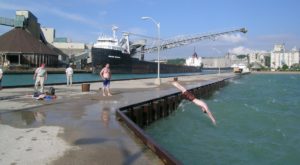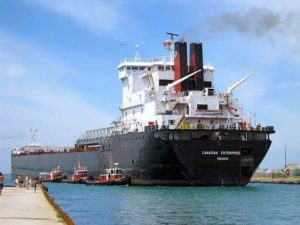Around the World
An Unusual Secret on the Shores of Lake Huron
Sep 2022 | By Pat Brennan
This Subterranean Mine is an Unusual Construction Site
Two miles out under Lake Huron, Rowland Howe is standing at a street corner waiting for a bus, on his way home from one of Ontario’s most unusual construction sites.
Howe is manager of the world’s largest salt mine — a massive labyrinth under the lakebed — and the biggest employer in Goderich.
Its his job to produce the stuff that causes those ugly white stains on your leather boots during the winter months.
On this construction site, there are more than 100 miles of roadways. They are part of an industrial town site that is larger than Goderich, the historic town on the surface.
Goderich’s Salt of The Earth
The mine, operated by Sifto Salt, (a subsidiary of Compass Minerals of Kansas) supplies much of the salt applied to the slippery streets each winter throughout Toronto and other cities in the Great Lakes area of U.S. and Canada.
Deep below the waters of the lake, more than 400 people work in this subterranean town. They chew away at walls of salt deposited about 400 million years ago by an ocean that covered the Great Lakes basin.
The mine is so large that it once had a bus system transporting miners out to their work areas a couple of miles off Goderich’s beaches.
“We used to operate a couple vehicles like a bus system to transport workers, but now there are so many routes to follow that we have about 30 or more John Deere Gators carrying workers out to the rock faces,” says Howe.
A Ship in a Bottle
 Some of the world’s largest dump trucks also rumble along these subterranean streets, which stretch wider than Yonge Street. The 40-ton behemoths are stripped down to their frames to be lowered 1,800 feet down the mine shift in bits and pieces, rebuilt, and never again see the light of day.
Some of the world’s largest dump trucks also rumble along these subterranean streets, which stretch wider than Yonge Street. The 40-ton behemoths are stripped down to their frames to be lowered 1,800 feet down the mine shift in bits and pieces, rebuilt, and never again see the light of day.
“It’s a little like building a ship in a bottle,” says Howe.
All maintenance and repairs are carried out in a large service depot carved out of the salt bed. So too are the lunch rooms for mine workers, storage caverns, workshops, rooms for electric transformers and a huge crushing plant that grinds salt blocks brought to the mill by the dump trucks and five miles of conveyor belts.
Rust is not an issue for these vehicles, even though they drive on roads of salt. There is a constant 65-degree temperature in the mine and little or no water seepage. Lake Huron is 200 feet deep in this area and the mine starts about 1,600 feet below the lake bottom.
Blasting at different locations in the mine each workday breaks loose big chunks of rock salt.
Miners will extract about six million tons of salt from the mine this year and much of it leaves town in the holds of large lake freighters, which tie up at Sifto’s front door. Trucks and trains also cart away the product as the salt is used in at least 1,000 other products as well as making slippery roads safe.
The miners chew out rooms of salt 60 feet by 60 feet, but leave pillars of the same size untouched to support the ceiling before moving on to the next room.
Striking (Unexpected!) Gold
 Sam Platt was looking for oil in Goderich in 1866 when his drill bit dug into a salt bed about 1,000 feet below the surface. He wasn’t disappointed, as salt was more valuable than oil in those days. Platt had discovered North America’s first salt bed.
Sam Platt was looking for oil in Goderich in 1866 when his drill bit dug into a salt bed about 1,000 feet below the surface. He wasn’t disappointed, as salt was more valuable than oil in those days. Platt had discovered North America’s first salt bed.
Near Platt’s drill site Sifto is still extracting salt the old way. They pump water down into the salt bed, bring up salt water and then evaporate the water. After a year of pumping water what’s left is 120,000 tons of 98.2 percent pure salt, which is used primarily for human consumption and in water softeners. Howe says the salt mine, which was opened in 1959, can be mined by many generations to come.

